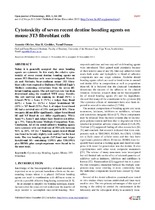| dc.contributor.author | Olivier, Annette | |
| dc.contributor.author | Grobler, Sias Renier | |
| dc.contributor.author | Osman, Yusuf Ismail | |
| dc.date.accessioned | 2013-05-03T13:43:01Z | |
| dc.date.available | 2013-05-03T13:43:01Z | |
| dc.date.issued | 2012 | |
| dc.identifier.citation | Olivier, A., Grobler, S. & Osman, Y. (2012). Cytotoxicity of seven recent dentine bonding agents on mouse 3T3 fibroblast cells. Open Journal of Stomatology. 2: 244 – 250 | en_US |
| dc.identifier.issn | 2160-8717 | |
| dc.identifier.uri | http://hdl.handle.net/10566/589 | |
| dc.description.abstract | Today it is generally accepted that most bonding agents are cytotoxic. In this study the relative cyto-toxicity of seven recent dentine bonding agents on mouse 3T3 fibroblast cells were investigated. Materials and Methods. Near-confluent mouse 3T3 fibro- blast cells were exposed to Dulbecco Modified Eagle’s Medium containing extractions from the seven different bonding agents. The cell survival rate was then determined using the standard MTT assay. Results. The cell survival rate ranking is: iBond (94%) < Gbond (78%) < Xeno V (71%) < Adper Easy Bond (63%) < Xeno V+ (61%) < Adper Scotchbond SE (33%) < XP Bond (32%). Part A of Adper Scotchbond SE had a survival rate of 35% and part B 38%. These two parts did not differ significantly. Adper Scotchbond SE and XP Bond do not differ significantly. While Xeno V+, Xeno V and Adper Easy Bond do not differ. (p < 5%; Tukey-Kramer Multiple-Comparison Test). Conclusion. All of the tested adhesive bonding agents were cytotoxic with survival rate of 3T3 cells between 94% to 31%. Of the 7 bonding agents tested iBond was found to be only slightly toxic and by far the least toxic. The two bonding agents (XP Bond and Adper Scotchbond SE) containing UDMA plus TEGDMA plus HEMA plus camphorquinone were found to be the most toxic. | en_US |
| dc.language.iso | en | en_US |
| dc.publisher | Scientific Research Publishing | en_US |
| dc.rights | © 2012 Olivier et al; licensee Scientific Research Publishing. This is an Open Access article distributed under the terms of the Creative Commons Attribution License, which permits unrestricted use, distribution, and reproduction in any medium, provided the original work is properly cited. | |
| dc.source.uri | http://dx.doi.org/10.4236/ojst.2012.24043 | |
| dc.subject | Cytotoxicity | en_US |
| dc.subject | Bonding Agents | en_US |
| dc.subject | Mouse 3T3 Fibroblast | en_US |
| dc.title | Cytotoxicity of seven recent dentine bonding agents on mouse 3T3 fibroblast cells | en_US |
| dc.type | Article | en_US |
| dc.privacy.showsubmitter | false | |
| dc.status.ispeerreviewed | true | |

